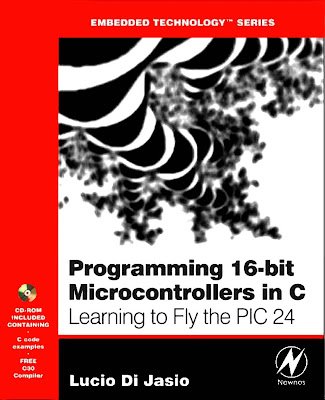 |
Programming 16-Bit PIC Microcontrollers in C Learning to Fly the PIC24 Lucio Di Jasio Reseña Most readers will associate Microchip's name with the ubiquitous 8-bit PIC microcontrollers but it is the new 16-bit PIC24F family that is truly stealing the scene. Orders of magnitude increases of performance, memory size and the rich peripheral set make programming these devices in C a must. This new guide by Microchip insider Lucio Di Jasio teaches readers everything they need to know about the architecture of these new chips: How to program them, how to test them, and how to debug them. |
| Di Jasio's common-sense, practical, hands-on approach starts out with basic functions and guides the reader step-by-step through even the most sophisticated programming scenarios. Experienced PIC users, including embedded engineers, programmers, designers, and SW and HW engineers, and new comers alike will benefit from the text's many thorough examples, which demonstrate how to nimbly sidestep common obstacles and take full advantage of the many new features. La mayoría de los lectores asociar el nombre de Microchip con los microcontroladores PIC de 8 bits en todas partes, pero es el nuevo 16-bit de la familia PIC24F que es realmente el robo de la escena. Los pedidos de aumentos de la magnitud de rendimiento, tamaño de memoria y el conjunto periférico rico que la programación de estos dispositivos en C una necesidad. Esta nueva guía de información privilegiada por Microchip Lucio Di Jasio enseña a los lectores todo lo que necesitan saber acerca de la arquitectura de estos nuevos chips: Cómo programarlos, cómo probarlos y cómo depurarlos. Di Jasio de sentido común, práctico, enfoque práctico comienza con funciones básicas y guía al lector paso a paso a través de incluso los escenarios de programación más sofisticadas. Los usuarios experimentados PIC, incluyendo ingenieros embebidos, programadores, diseñadores, ingenieros y SW y HW, y recién llegados se beneficiarán de muchos ejemplos a fondo del texto, que demuestran cómo esquivar ágilmente los obstáculos comunes y sacar el máximo provecho de las nuevas características. |
| INDICE |
|
| Consulta el Libro (8 MB) por: |
| Para los que usan Gestores de Descarga |
http://adf.ly/MUuht
http://adf.ly/MUuhv
http://adf.ly/MUuhw
http://adf.ly/MUuhx
|
INDICE GENERAL |
|

Hola Profe !!!
ResponderEliminarEsto si es un buen libro !!!!!
Gracias por tu labor.
Un saludo de Manel desde Barcelona, España.